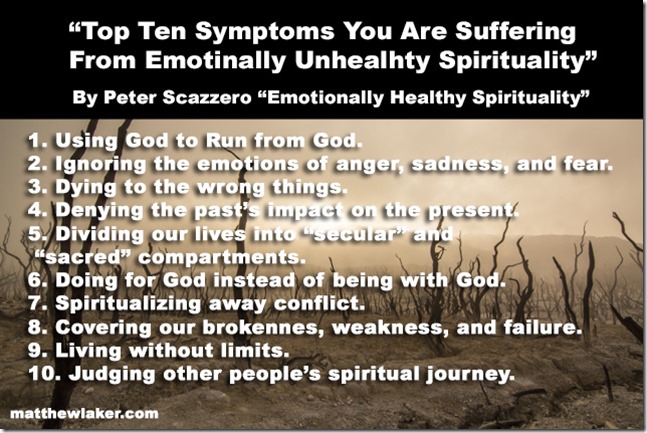“Emotionally healthy Spirituality” by Peter Scazzero was my lent reading for 2016.
The following are some personal takeaways through my experience of reading the book.
The core message of the book is “When emotional heath and contemplative spirituality are interwoven together in an individual’s life, a small group, a church, a university fellowship, or a community, people’s lives are dramatically transformed. They work as an antidote to heal the symptoms of emotionally unhealthy spirituality…”[1]
“Awareness of yourself and your relationship with God are intricately related. In fact, the challenge to shed our “old false” self in order to live authentically in our “new true” self strikes at the very core of true spirituality.”[2]
Here are my personal takeaways – in no order
1. His Honesty in asking why he was not experiencing or seeing emotional or spiritual maturity in the church or himself.
One person I was recently coaching shared that if the church really believed who Jesus says he was, we should be acting differently. At times, the church is guilty of telling people to love more or love better. However, that is not good enough. Over the last number of years, I have started to wrestle more with why we are not seeing the transformation in people’s lives that the gospel is calling us to. The author’s hope was to help us be transformed.
2. Wrestling with deeply rooted behavioral patterns that move us away from Christ.
Many of us have underestimated how deep sin goes in our life. Many of us have underestimated how deeply entrenched the old ways and patterns are in our life. In chapter five, he talks about going back in order to move forward. He challenges the reader to understand behaviors and patterns that have entrenched themselves in our life.
3. Top 10 symptoms indicating someone is suffering from a base case of emotionally unhealthy spirituality
4. We have a problem, but here are some paths that could help.
Scazzero does point out in chapter two five components of who we are. However, this book only focuses on two parts as foundationally. I appreciate him trying to provide some initial practical steps to help people grow in their faith. Not only is this useful for my own personal journey, but I can introduce them easily to other people.
5. Pay attention to emotion and pain.
One of the big takeaways for me was the call to not push the emotion away. Throughout the book is a call to ask questions about what you are feeling. What are your emotions telling you? What is God saying through those emotions or pain? Where is God in this moment? There is a call to not fully give ourselves over to the whim of emotions, but also understand they are God given, so do not fear them. I am not sure this is well understood in the church.
6. A Rule of Life.
The author gives a great illustration of a trellis that helps us abide in Christ and become fruitful. The trellis is a combination of the spiritual practices that provide structure for me to intentionally pay attention and remember God in everything I do. The fruit that comes from that is seen in how we live our life.
Throughout the book is a desire to provide practical skills for people to apply in their life. The idea of developing a rule of life reminds me a little of developing a life plan. It is the whole idea of being intentional in your life.
When I started the book the hope was it would serve as an avenue of personal reflection and deepening of my life. It has helped with that.
You can check out the book here.
Resource:
I found some mp3 of his teaching around this here. –http://ncdefca.org/resources/conference/2010-emotionally-healthy-spirituality-pete-scazzero/
[1]Scazzero, Peter “Emotionally Healthy Spirituality” (Tennesse, Thomas Nelson, 2006), p.44
[2] Ibid, p.65


